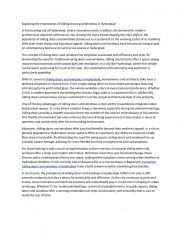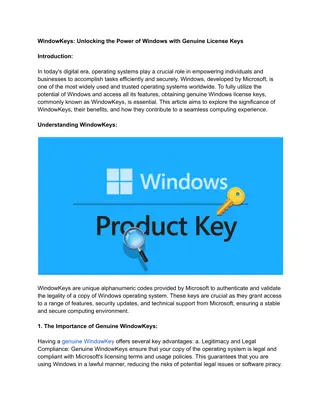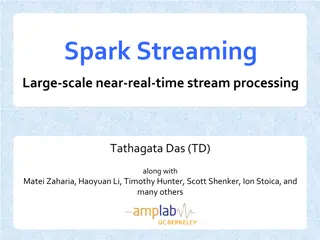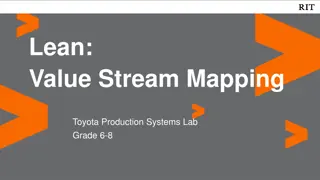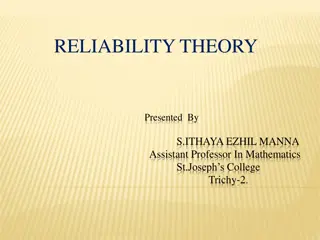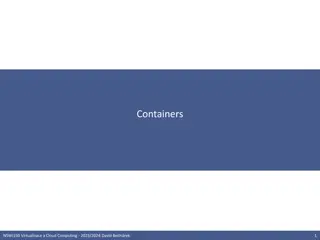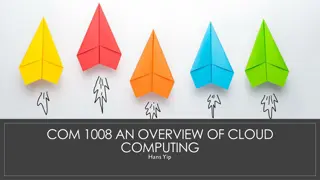Reliable Stream Transport Service: Providing Reliability with Sliding Windows
Most reliable protocols use positive acknowledgement with retransmission to ensure data integrity and reliability. Sliding window protocols optimize network bandwidth by allowing multiple packet transmissions with efficient acknowledgment handling. This concept minimizes unacknowledged packets and ensures smooth data flow across networks.
Download Presentation

Please find below an Image/Link to download the presentation.
The content on the website is provided AS IS for your information and personal use only. It may not be sold, licensed, or shared on other websites without obtaining consent from the author.If you encounter any issues during the download, it is possible that the publisher has removed the file from their server.
You are allowed to download the files provided on this website for personal or commercial use, subject to the condition that they are used lawfully. All files are the property of their respective owners.
The content on the website is provided AS IS for your information and personal use only. It may not be sold, licensed, or shared on other websites without obtaining consent from the author.
E N D
Presentation Transcript
RELIABLE STREAM TRANSPORT SERVICE (TCP)
Providing Reliability: Most reliable protocols use a single fundamental technique known as positive acknowledgement with retransmission. The technique requires a recipient to communicate with the source, sending back an acknowledgement (ACK) message as it receives data. The sender keeps a record of each packet it sends and waits for an acknowledgement before sending the next packet. The sender also starts a timer when it sends a packet and retransmits a packet if the timer expires before an acknowledgement arrives.
When a packet is lost or corrupted. The sender starts a timer after transmitting a packet. When the timer expires, the sender assumes the packet was lost and retransmits it.
The Idea Behind Sliding Windows: Sliding window protocols use network bandwidth better because they allow the sender to transmit multiple packets before waiting for an acknowledgement. The easiest way to envision sliding window operation is to think of a sequence of packets to be transmitted. The protocol places a small, fixed-size window on the sequence and transmits all packets that lie inside the window.
We say that a packet is unacknowledged if it has been transmitted but no acknowledgement has been received. Technically, the number of packets that can be unacknowledged at any given time is constrained by the window size and is limited to a small, fixed number. Once the sender receives an acknowledgement for the first packet inside the window, it "slides" the window along and sends the next packet. The window continues to slide as long as acknowledgements are received. The performance of sliding window protocols depends on the window size and the speed at which the network accepts packets.
A sliding window protocols always remembers which packets have been acknowledged and keeps a separate timer for each unacknowledged packet. If a packet is lost, the timer expires and the sender retransmits that packet When the sender slides its window, it moves past all acknowledged packets. At the receiving side, the protocol software keeps an analogous window, accepting and acknowledging packets as they arrive. The window partitions the sequence of packets into three sets: 1. Those packets to the left of the window have been successfully transmitted, received and acknowledged 2. Those packets to the right have not yet been transmitted 3. Those packets that lie in the window are being transmitted
The Transmission Control Protocol (TCP): TCP is a communication protocol, not a piece of software. The protocol specifies the format of the data and acknowledgements that two computers exchange to achieve a reliable transfer, as well as the procedures the computers use to ensure that the data arrives correctly. It specifies how TCP software distinguishes among multiple destinations on a given machine, and how communicating machines recover from errors like lost or duplicated packets. The protocol also specifies how two computers initiate a TCP stream transfer and how they agree when it is complete.
Passive And Active Opens: Before TCP traffic can pass across an internet, application programs at both ends of the connection must agree that the connection is desired. To do so, the application program on one end performs a passive open function by contacting its operating system and indicating that it will accept an incoming connection. The application program at the other end must then contact its operating system using an active open request to establish a connection. The two TCP software modules communicate to establish and verify a connection. Once a connection has been created, application programs can begin to pass data; the TCP software modules at each end exchange messages that guarantee reliable delivery.
Acknowledgements And Retransmission: Each acknowledgement specifies a sequence value one greater than the highest octet position in the contiguous prefix it received. A TCP acknowledgement specifies the sequence number of the next octet that the receiver expects to receive. The TCP acknowledgement scheme is called cumulative because it reports how much of the stream has accumulated. Advantage: acknowledgements are both easy to generate and unambiguous. Lost acknowledgements do not necessarily force retransmission. A major disadvantage is that the sender does not receive information about all successful transmissions, but only about a single position in the stream that has been received.
Timeout And Retransmission: In an internet, a segment traveling between a pair of machines may traverse a single, low-delay network (e.g., a high-speed LAN), or it may travel across multiple intermediate networks through multiple routers. Thus, it is impossible to know a prior how quickly acknowledgements will return to the source. Furthermore, the delay at each router depends on traffic, so the total time required for a segment to travel to the destination and an acknowledgement to return to the source varies dramatically from one instant to another. Figure 13.10, which shows measurements of round trip times across the global Internet for 100 consecutive packets, illustrates the problem
TCP accommodates varying internet delays by using an adaptive retransmission algorithm. To collect the data needed for an adaptive algorithm, TCP records the time at which each segment is sent and the time at which an acknowledgement arrives for the data in that segment. From the two times, TCP computes an elapsed time known as a sample round trip time or round trip sample. Whenever it obtains a new round trip sample, TCP adjusts its notion of the average round trip time for the connection.
Usually, TCP software stores the estimated round trip time, RTT, as a weighted average and uses new round trip samples to change the average slowly. For example, when computing a new weighted average, one early averaging technique used a constant weighting factor, , where 0 < 1, to weight the old average against the latest round trip sample: Choosing a value for a close to 1 makes the weighted average immune to changes that last a short time. Choosing a value for a close to 0 makes the weighted average respond to changes in delay very quickly.
When it sends a packet, TCP computes a timeout value as a function of the current round trip estimate. Early implementations of TCP used a constant weighting factor, ( > I), and made the timeout greater than the current round trip estimate: The original specification recommended setting =2. To accommodate the varying delays encountered in an internet environment, TCP uses an adaptive retransmission algorithm that monitors delays on each connection and adjusts its timeout parameter accordingly.
Karn'sAlgorithm And Timer Backoff: Consider what happens when TCP sends a segment after a sharp increase in delay. TCP computes a timeout using the existing round trip estimate. The timeout will be too small for the new delay and will force retransmission. If TCP ignores acknowledgements from retransmitted segments, it will never update the estimate and the cycle will continue. To accommodate such failures, Karn's algorithm requires the sender to combine retransmission timeouts with a timer backoff strategy.
The backoff technique computes an initial timeout using a formula like the one shown above. Implementations use a variety of techniques to compute backoff. Most choose a multiplicative factor, , and set the new value to: new_timeout = * timeout Typically, is 2. When computing the round trip estimate, ignore samples that correspond to retransmitted segments, but use a backoff strategy, and retain the timeout value from a retransmitted packet for subsequent packets until a valid sample is obtained.
Establishing A TCP Connection: To establish a connection, TCP uses a three-way handshake.
Silly Window Syndrome: Early TCP implementations exhibited a problem known as silly window syndrome in which each acknowledgement advertises a small amount of space available and each segment carries a small amount of data. This can be handled in several ways:
Delayed Acknowledgements: TCP delays sending an acknowledgement when silly window avoidance specifies that the window is not sufficiently large to advertise. The standards recommend delaying acknowledgements. The chief advantage arises because delayed acknowledgements can decrease traffic and thereby increase throughput. For example, if additional data arrives during the delay period, a single acknowledgement will acknowledge all data received. Furthermore, TCP cannot move its window until the receiving application extracts data from the buffer. In cases where the receiving application reads data as soon as it arrives, a short delay allows TCP to send a single segment that acknowledges the data and advertises an updated window.
The disadvantages of delayed acknowledgements should be clear. Most important, if a receiver delays acknowledgements too long, the sending TCP will retransmit the segment. Unnecessary retransmissions lower throughput because they waste network bandwidth. In addition, retransmissions require computational overhead on the sending and receiving machines. Furthermore, TCP uses the arrival of acknowledgements to estimate round trip times; delaying acknowledgements can confuse the estimate and make retransmission times too long. To avoid potential problems, the TCP standards place a limit on the time TCP delays an acknowledgement. Implementations cannot delay an acknowledgement for more than 500 milliseconds.
Send-Side Silly Window Avoidance (Nagles Algorithm): The goal is to avoid sending small segments. Bt a sending application can generate data in arbitrarily small blocks (e.g., one octet at a time). Thus, to achieve the goal, a sending TCP must allow the sending application to make multiple calls to write, and must collect the data transferred in each call before transmitting it in a single, large segment. That is, a sending TCP must delay sending a segment until it can accumulate a reasonable amount of data. The technique is known as clumping.
When a sending application generates additional data to be sent over a connection for which previous data has been transmitted but not acknowledged, place the new data in the output buffer as usual, but do not send additional segments until there is sufficient data to fill a maximum-sized segment. If still waiting to send when an acknowledgement arrives, send all data that has accumulated in the buffer. Apply the rule even when the user requests a push operation. TCP now requires the sender and receiver to implement heuristics that avoid the silly window syndrome. A receiver avoids advertising a small window, and a sender uses an adaptive scheme to delay transmission so it can clump data into large segments.
If an application generates data one octet at a time, TCP will send the first octet immediately. However, until the ACK arrives, TCP will accumulate additional octets in its buffer. Thus, if the application is reasonably fast compared to the network (i.e., a file transfer), successive segments will each contain many octets. If the application is slow compared to the network (e.g., a user typing on a keyboard), small segments will be sent without long delay.


